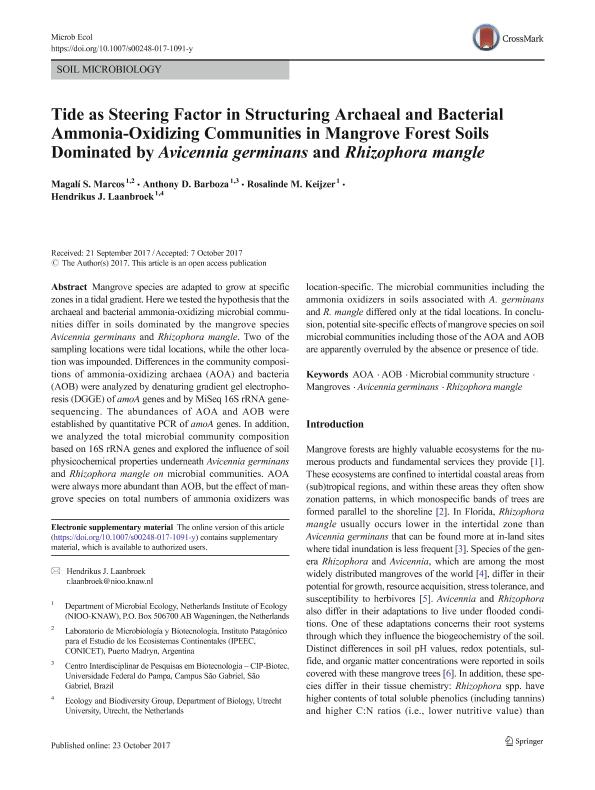Artículo
Tide as Steering Factor in Structuring Archaeal and Bacterial Ammonia-Oxidizing Communities in Mangrove Forest Soils Dominated by Avicennia germinans and Rhizophora mangle
Fecha de publicación:
05/2018
Editorial:
Springer
Revista:
Microbial Ecology
ISSN:
0095-3628
e-ISSN:
1432-184X
Idioma:
Inglés
Tipo de recurso:
Artículo publicado
Clasificación temática:
Resumen
Mangrove species are adapted to grow at specific zones in a tidal gradient. Here we tested the hypothesis that the archaeal and bacterial ammonia-oxidizing microbial communities differ in soils dominated by the mangrove species Avicennia germinans and Rhizophora mangle. Two of the sampling locations were tidal locations, while the other location was impounded. Differences in the community compositions of ammonia-oxidizing archaea (AOA) and bacteria (AOB) were analyzed by denaturing gradient gel electrophoresis (DGGE) of amoA genes and by MiSeq 16S rRNA gene-sequencing. The abundances of AOA and AOB were established by quantitative PCR of amoA genes. In addition, we analyzed the total microbial community composition based on 16S rRNA genes and explored the influence of soil physicochemical properties underneath Avicennia germinans and Rhizophora mangle on microbial communities. AOA were always more abundant than AOB, but the effect of mangrove species on total numbers of ammonia oxidizers was location-specific. The microbial communities including the ammonia oxidizers in soils associated with A. germinans and R. mangle differed only at the tidal locations. In conclusion, potential site-specific effects of mangrove species on soil microbial communities including those of the AOA and AOB are apparently overruled by the absence or presence of tide.
Archivos asociados
Licencia
Identificadores
Colecciones
Articulos(IPEEC)
Articulos de INSTITUTO PATAGONICO PARA EL ESTUDIO DE LOS ECOSISTEMAS CONTINENTALES
Articulos de INSTITUTO PATAGONICO PARA EL ESTUDIO DE LOS ECOSISTEMAS CONTINENTALES
Citación
Marcos, Magalí Silvina; Barboza, Anthony D.; Keijzer, Rosalinde M.; Laanbroek, Hendrikus J.; Tide as Steering Factor in Structuring Archaeal and Bacterial Ammonia-Oxidizing Communities in Mangrove Forest Soils Dominated by Avicennia germinans and Rhizophora mangle; Springer; Microbial Ecology; 75; 4; 5-2018; 997-1008
Compartir
Altmétricas




